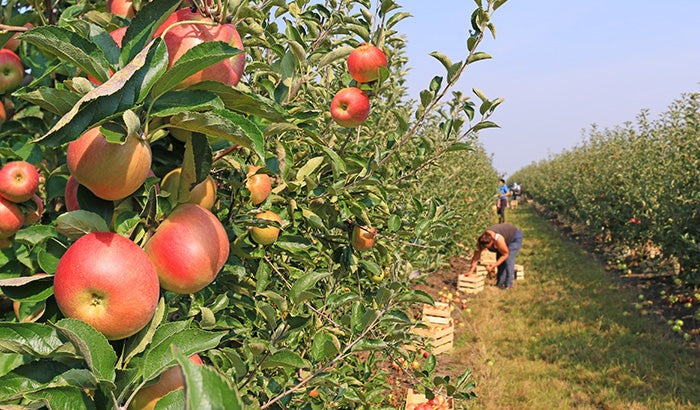Essential Tools for Tree Care
Maintaining fruit trees, particularly apple trees, requires more than enthusiasm; it demands the right tools to ensure healthy growth, bountiful harvests, and longevity. This article explores the essential tools for tree care, focusing on their practical applications for fruit trees, with an emphasis on apple trees, while providing insights into their selection and use for gardeners across the UK. From pruning shears to soil testing kits, each tool plays a critical role in nurturing a thriving orchard. A nursery specialist from Fruit-Trees offers professional advice to guide gardeners in equipping themselves effectively.
A well-maintained fruit tree can yield decades of harvests, but neglect or improper care can lead to disease, poor fruit quality, or structural weaknesses. For those looking to buy fruit trees, investing in quality tools from the outset is as important as choosing the right variety. A specialist from Fruit-Trees advises, “Selecting the appropriate tools for pruning and maintenance is vital for the health of your fruit trees. High-quality equipment, such as sharp pruning shears and sturdy ladders, ensures precise cuts and safe access, promoting vigorous growth and abundant yields. For a wide range of apple trees and care resources, explore our offerings.” This guidance underscores the importance of equipping oneself adequately before planting, ensuring trees thrive in the British climate.
Pruning Tools: The Backbone of Tree Care
Pruning is a cornerstone of fruit tree maintenance, particularly for apple trees, which require regular shaping to encourage fruit production and maintain structural integrity. The primary tool for this task is a pair of high-quality pruning shears, also known as secateurs. These handheld tools are designed for cutting branches up to 2.5 centimetres in diameter. For British gardeners, choosing bypass secateurs, which feature a scissor-like cutting action, is advisable for clean cuts that minimise damage to the tree. Felco and Spear & Jackson are reputable brands known for their durability and ergonomic designs, suited to prolonged use in damp UK conditions.
For larger branches, loppers are indispensable. These long-handled tools provide the leverage needed to cut branches up to 5 centimetres thick. Telescopic loppers, which allow handle length adjustments, are particularly useful for reaching higher branches without straining. When pruning apple trees, aim to remove dead, damaged, or crossing branches during the dormant season, typically late winter to early spring, to stimulate healthy growth. A pruning saw is another essential tool for branches too thick for loppers, typically those exceeding 5 centimetres. Folding pruning saws with replaceable blades offer portability and precision, making them ideal for intricate cuts in crowded canopies.
Ladders and Pole Pruners: Reaching New Heights
Apple trees can grow to significant heights, often requiring tools to access upper branches safely. A sturdy orchard ladder, designed with a tripod base for stability on uneven ground, is a must for tasks like pruning, thinning, or harvesting. Aluminium ladders are lightweight yet robust, suitable for the variable weather of British gardens. Ensure the ladder is rated for the user’s weight and height requirements, and always position it on firm ground to prevent accidents.
For tasks that don’t require direct access, pole pruners extend reach without the need for a ladder. These tools feature a cutting head mounted on a long pole, operated by a rope or lever system. Pole pruners are ideal for removing high branches or thinning fruit to prevent overcrowding, a common practice in apple tree care to improve fruit size and quality. Adjustable poles, which extend up to 4 metres or more, offer versatility for trees of varying heights. When using pole pruners, maintain a firm grip and avoid overreaching to ensure safety and precision.
Soil Management Tools: Nurturing the Roots
A fruit tree that thrives is built on healthy soil, and long-term success depends on having the right soil management tools. Gardeners can assess pH levels and nutrient content with a soil testing kit, which is a priceless investment. Apple trees like soil that is slightly acidic (pH 6.0 to 7.0) as opposed to neutral. Testing kits, which can be purchased online or at garden centres, give precise readings and direct the addition of substances like sulphur to reduce pH or lime to boost it. Maintaining appropriate soil conditions for fertiliser absorption requires routine testing, ideally once a year.
A garden fork is essential for soil preparation and maintenance. When planting new fruit trees, a fork helps break up compacted soil and incorporate organic matter like compost, improving drainage and root development. For those planning to buy fruit trees, preparing the planting site with a fork ensures a welcoming environment for young roots. Spades are equally important for digging planting holes, typically 60 centimetres wide and deep, to accommodate the tree’s root system without crowding. Stainless steel spades resist rust, a practical choice for the UK’s wet climate.
Watering and Irrigation Tools: Sustaining Growth
Watering is a critical aspect of tree care, especially during the establishment phase after planting. A watering can with a fine rose attachment allows precise application to the root zone, preventing water waste and leaf damage. For larger orchards, a hose with an adjustable nozzle offers flexibility, delivering a gentle spray for young trees or a stronger jet for cleaning tools. Drip irrigation systems are an efficient option for consistent moisture delivery, particularly in dry spells common in southern England. These systems reduce water usage and target the root zone directly, promoting deep root growth in apple trees.
For gardeners looking to buy fruit trees, understanding watering needs is crucial. Young trees require regular watering, typically 10 to 15 litres weekly, depending on rainfall and soil type. A moisture meter can help monitor soil hydration levels, preventing overwatering, which can lead to root rot. These affordable devices are inserted into the soil to provide instant readings, ensuring trees receive the right amount of moisture.
Pest and Disease Management Tools: Protecting Your Trees
Fruit trees, including apples, are susceptible to pests like aphids and diseases such as apple scab. Tools for pest and disease management are essential for maintaining tree health. A handheld sprayer, with a capacity of 1 to 2 litres, is ideal for applying organic treatments like neem oil or fungicides. For larger trees, a backpack sprayer offers greater capacity and ease of use, allowing thorough coverage of the canopy. Always follow product instructions and apply treatments during calm weather to avoid drift.
Sticky traps and pheromone traps are non-chemical tools for monitoring and controlling pests. Yellow sticky traps attract flying insects like whiteflies, while pheromone traps target specific pests like codling moths, a common apple tree threat. Regular inspection of traps helps gardeners assess pest levels and take timely action. For physical barriers, tree guards protect young trunks from rabbits and deer, common in rural British gardens. Plastic or mesh guards are easy to install and remove as the tree matures.
Harvesting Tools: Reaping the Rewards
Harvesting is the culmination of tree care efforts, and the right tools make it efficient and safe. A fruit picker, a basket-like tool mounted on a pole, allows gardeners to collect apples from high branches without damaging the fruit or tree. These tools are particularly useful for taller apple varieties like Cox’s Orange Pippin, which may grow beyond arm’s reach. For lower branches, a simple canvas picking bag worn over the shoulder keeps hands free and prevents bruising.
When planning to buy fruit trees, consider varieties suited to your harvesting capabilities. Dwarf or semi-dwarf apple trees, for instance, are easier to manage for small-space gardeners. A sharp pair of scissors or small pruning shears is useful for thinning fruit earlier in the season, ensuring larger, healthier apples at harvest. Thinning involves removing excess fruitlets, typically in June, to reduce branch strain and improve quality.
Maintenance and Storage: Prolonging Tool Life
Proper maintenance of tree care tools ensures their longevity and effectiveness. A sharpening stone or file is essential for keeping pruning shears, loppers, and saws in top condition. Regular sharpening, ideally after each major pruning session, maintains clean cuts that promote tree health. Cleaning tools with a disinfectant, such as diluted bleach, prevents the spread of diseases between trees. For British gardeners, storing tools in a dry shed or garage is crucial to protect against rust, given the country’s humid climate.
Tool bags or wall-mounted racks keep equipment organised and accessible. For those investing in a range of tools to care for newly purchased fruit trees, a dedicated storage system prevents loss and damage. Regularly inspect tools for wear, replacing blades or handles as needed to maintain performance. Quality tools, while initially more expensive, offer better durability and precision, reducing the need for frequent replacements.
Choosing the Right Tools for Your Garden
Selecting tools depends on the scale of your orchard and the specific needs of your trees. For a single apple tree in a small garden, a basic kit of secateurs, a pruning saw, a soil testing kit, and a watering can may suffice. Larger orchards require additional investments like loppers, pole pruners, and sprayers. When deciding to buy fruit trees, factor in the long-term commitment to their care and budget for tools accordingly. Local garden centres and online retailers offer a range of options, with brands like Wolf Garten and Draper providing reliable choices for British conditions.
For novice gardeners, starting with versatile, multi-purpose tools can ease the learning curve. As skills develop, specialised tools like telescopic loppers or drip irrigation systems can enhance efficiency. Joining a local gardening club or consulting resources from nurseries ensures informed decisions. Their expertise helps gardeners match tools to tree varieties and regional climates, maximising success.
The Long-Term Benefits of Proper Tool Use
Using the right tools not only simplifies tree care but also enhances tree health and productivity. Regular pruning with sharp shears prevents disease and encourages fruiting, while soil testing and proper watering optimise growth. Pest management tools protect yields, and harvesting tools ensure the fruits of your labour are enjoyed without waste. For apple trees, which can live for decades, consistent care with quality tools translates to years of abundant harvests.
Gardeners looking to buy fruit trees should view tools as an investment in their orchard’s future. A well-equipped gardener can address challenges like poor soil, pests, or structural issues before they escalate, ensuring trees remain productive. The satisfaction of picking home-grown apples, free from supermarket mark-ups, is a reward worth the effort. By prioritising tool quality and maintenance, British gardeners can cultivate thriving orchards that enhance both their gardens and their tables.
Conclusion
Caring for fruit trees, particularly apple trees, is a rewarding endeavour that requires a thoughtful selection of tools. From pruning shears to soil testing kits, each tool serves a specific purpose in promoting tree health and maximising yields. By investing in quality equipment and following best practices, gardeners across the UK can enjoy the fruits of their labour for years to come. Whether you’re a novice or an experienced orchardist, equipping yourself with the essential tools for tree care is the first step toward a flourishing garden.













Post Comment